Years ago, I had built and sailed a 14′ flat-bottomed skiff, but the time had come for something with more capacity, capability, and comfort. A few times my wife Ramona and I had been caught in rough conditions that made me feel more than a bit uncomfortable, and I didn’t feel confident heading out to distant shores with the little boat. And sleeping under a tented boom, well, I’d had enough of that. Still, it was nice to have a boat I could tow home and store in the garage where I could keep it in good repair.
Selway Fisher’s Ptarmigan 17, as drawn, met most of my needs and could be adapted to suit the rest. The options detailed in the plans took care of my wants, and the design appears to accommodate amateur builders with a range of skills and requirements. There are drawings for both stitch-and-tape and glued-plywood lapstrake construction. You can also choose between a simple catboat rig and a yawl rig. With all the options for customization, I wouldn’t be surprised to see 10 different boats built from the same set of Ptarmigan 17 plans.
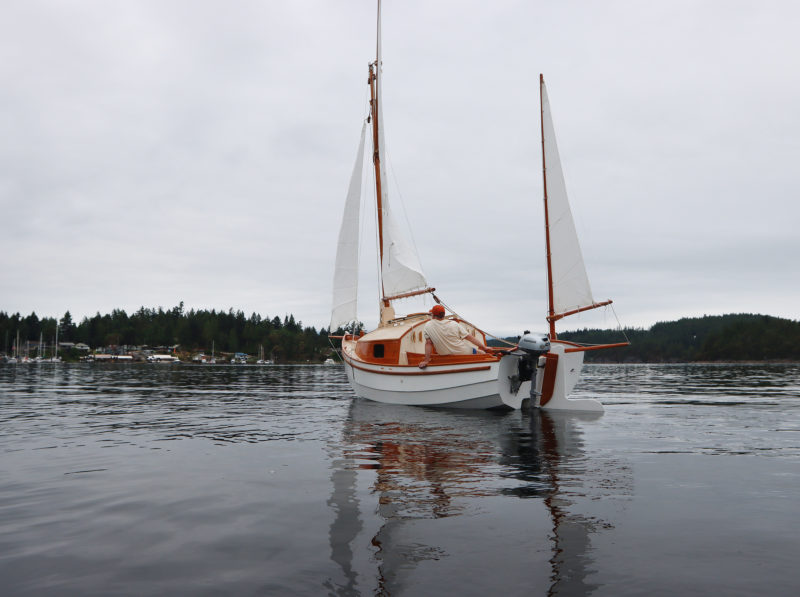 Pat Beninger
Pat BeningerThe glued-plywood lapstrake construction accentuates the hull’s curves. Stitch-and-tape construction without the laps is an option included in the plans.
The boat’s optional yawl rig had piqued my interest. I liked the idea of sailing under a balanced helm if the conditions got too serious, and I thought that the smaller mainmast on the yawl rig would be a bit lighter to lift. The combination tabernacle-equipped mainmast, small cabin, and ease of trailering led me to finally choose this design.
The building package comes with seven sheets of construction plans and a 14-page booklet of instructions. Dimensions are metric. A concise building schedule outlines each step of the build with recommendations on the choice of plywood, instructions on using epoxy, and what fastenings to use. There’s a section on how to lay out and draw the side panels on the plywood, and how to draw curved elements using a grid pattern. Measured drawings for the molds, stitch-and-tape side panels, bottom panel, and stem are clear and easy to follow. You do not need to do any lofting to build this boat. There are detailed drawings and instructions on stitching and filleting. The plans are complete with details for building sub-components such as rudder, centerboard and trunk, and the tabernacle. The plans are cross-referenced with the instruction booklet and provide the recommended scantlings.
There are instructions for building an outboard well or a transom cutout. All specifications for the standing and running rigging are listed. For builders interested in making their own sails, there’s even a reference to a Selway publication on that topic. The booklet is light on details for the four-strake, glued-lap plywood version; however, there are several good books available on the topic.
Both of the Ptarmigan 17’s sail rigs are gaff-rigged. The single-mast catboat rig carries a sail area of 139 sq ft and includes the dimensions for an optional 24-sq-ft jib. The yawl rig’s total sail area is a little smaller at 135 sq ft, with a main of 79 sq ft, a jib of 36 sq ft, and a leg-o’-mutton mizzen of 20 sq ft. There are two reefpoints drawn on the mainsails. With the yawl rig you can douse the mainsail in high winds and sail with a balanced helm under jib and mizzen. The yawl—with bowsprit and boomkin —is almost 23′ in sparred length. The mizzen is self-tending and only requires attention when coming off the wind. The plans do not specifically address tackle, but we made our own blocks in keeping with the overall look and feel of the boat. There are several good articles on making your own blocks in various publications.
I found the plans for this boat detailed, complete, and accurate, and while a few questions did arise, they were quickly answered via email. When I started this build, I found many ways of keeping safe and saving time; the project took me five months of full-time effort.
The boat tows well behind an SUV or pickup truck, and the trailer does not require brakes for the boat’s 1,300 lbs. The flat bottom and shallow 6″ keel help keep the weight low in the boat. For trailering, I keep the bowsprit attached and secure the mast in a cross-framed 2×4 support; the gaff, boom, and mizzen are supported and strapped to the frame and the forward ends pass through the companionway.
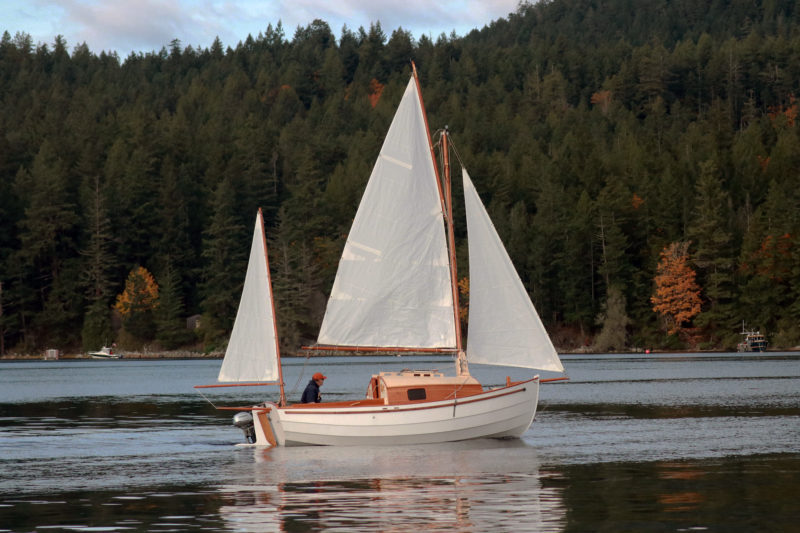 Rick Crook
Rick CrookThe yawl rig has an 18.9 sq ft mizzen, a 78.8 sq ft main, and a 36.6 sq ft headsail.
With some practice, the yawl can be rigged and ready to go in about 20–25 minutes. It saves time to tag the rigging to help remember where the stays go and in what order they go on. The mast is lifted with its three stays, three halyards, and the topping lift set in place. The foot of the mast is secured in the tabernacle. Lifting the rigged mast requires some effort but is manageable and made easier with the help of someone pulling on the headstay. I secure the jaws of both the gaff and the boom using 1/8″ braided nylon cord with several parrel beads threaded on. I lace on the sails, add the rudder and motor, take off the securing straps, and I’m set to launch. When hauling out at the ramp, I have a 2,000-lb single-speed hand-operated winch that handles the boat with ease. The boat always seems to attract a crowd filled with compliments, comments, and questions.
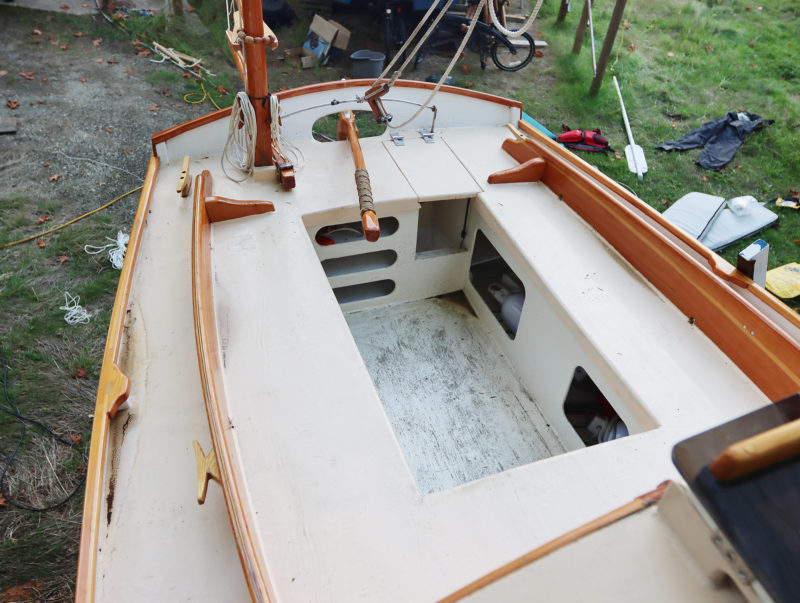 Steve Cormack
Steve CormackThe plans call for open slats for the cockpit seating and sole. The builder’s modification to plywood enclosures provides convenient storage.
The 5′x 6′ cockpit will accommodate four but is most comfortable with one or two. With two, there’s plenty of room to hoist the sails and move around when coming about. The helmsman has a clear view forward of the small jib over the cabin. The mainsail is high enough off the cabin roof to have a clear view to port and starboard. All sheets and halyards are led aft into the cockpit and can be easily handled without the need for winches. The throat and peak halyards need a hefty tug. The plans call for 7mm (3/8″) halyards, which I find easy on the hands. The 65″ x 25″ footwell is 17″ deep. The trunk is 4″ wide and its cap is 12″ above the cockpit sole. It extends into the footwell 20″ and passes through the main bulkhead to within a foot of the forepeak bulkhead. The steel centerboard is raised and lowered with the help of a worm-gear winch that is operated from the cockpit. With the board down, the boat draws 3-1/2′.
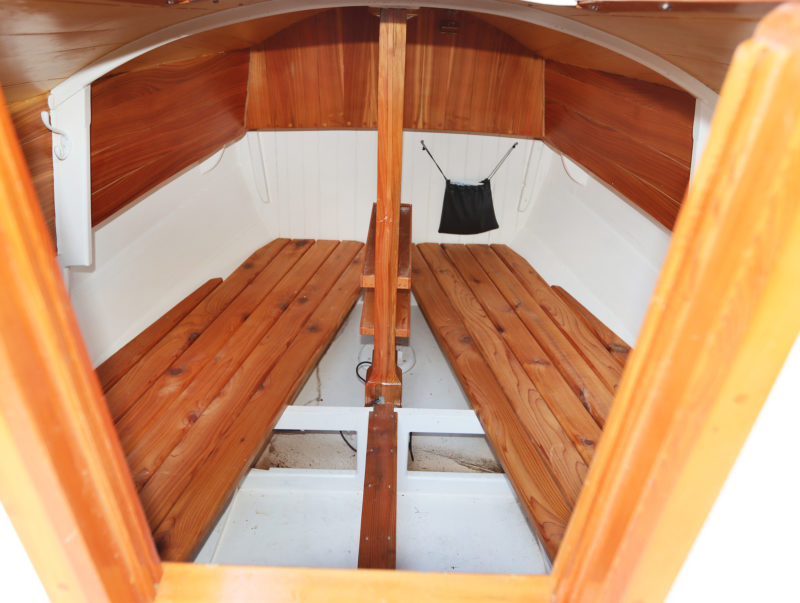 Steve Cormack
Steve CormackThe cabin has bunks for two. The centerboard trunk divides the footwell between them.
The cabin interior is 6-1/2′ x 5-1/2′ and is 52″ high at the crown. There are two bunks that run the length of the cabin and are 26″ at their widest. For sitting there is good headroom and ample legroom in the footwell between the bunks. Storage compartments are built into the underside of each bunk. It’s a simple interior, but it keeps you dry. The yawl cabin has a support post under the tabernacle that is about 16″ abaft the forepeak bulkhead. The tabernacle in the catboat version is supported by the forepeak bulkhead. The plans call for a sliding plywood hatch over the companionway, but I chose to make mine with a plexiglass top for added light in the cabin. There are two 12″ x 16″ windows on the cabin sides. If you wish to build a self-righting boat, the instruction booklet calls for adding buoyancy under the cockpit benches and forward of the forepeak bulkhead. An additional 160 lbs of lead can be bolted to the floor as extra ballast.
The boat’s 1,300-lb weight gives the feeling of stability—it is not tippy when you step aboard—and will carry through when tacking in light air. The Ptarmigan 17 was designed for inland lakes, estuaries, and coastal areas, and I have never felt uncomfortable in these waters. Adding one or two larger sails both on the jib and mizzen would be nice to have for sailing downwind and in lighter wind conditions. In windy conditions, the first reef goes in when the winds approach 20 knots. Anything above this and the main is doused and tied off. Even in these conditions the boat has never left me feeling unsafe; it feels stable and there is no need to put the rail in the water. The ride is generally dry, with little spray. Passengers in the cockpit can sit close behind the cabin to shelter from the elements. The rudder is shallow and extends 3’ beyond the transom. It controls the boat well in all conditions.
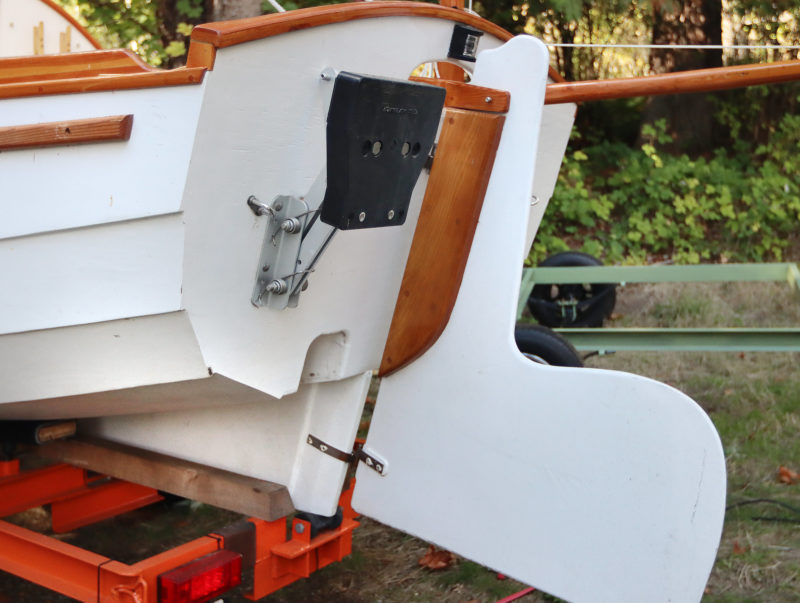 Steve Cormack
Steve CormackWhile the builder ultimately chose to use an outboard bracket, his Ptarmigan 17 has a built-in motorwell appropriate for a small outboard. The opening of the well is visible at the bottom of the transom.
The plans and notes describe an optional motorwell, set to starboard, but do not specify the size of the auxiliary outboard motor. A 2.5-hp is all Ramona and I need to get into and out of the harbor, or back home when the wind dies. I built the motorwell to house an electric trolling motor but found that I needed more power, so I switched to a small gas motor that I set on a transom-mounted bracket. The motorwell could easily accommodate the 2.5-hp outboard.
When I decided to build this boat there wasn’t a lot of information on how the boat would perform. A few pictures and a description by the designer were all that I had. My experience with a smaller boat helped refine my requirements for the new boat, which the Ptarmigan 17 met: capable of crossing the larger lakes in almost any condition, easily towed behind our pickup, and equipped with a dry bed to crawl into at night. I did make some modifications, such as building a self-draining footwell and building fiberglass-covered benches to drain the rainwater over the side. To provide more storage space, I extended the forward ends of the side benches, covering the centerboard trunk with more seating. Now I can leave the boat unattended at a mooring without having to worry about the cockpit filling with water.
If you’re looking for a small cruising sailboat to explore far and wide, that you can easily trailer and store at home in between adventures, then you should take a close look at the Ptarmigan 17. Just be ready for the many admirers you’ll meet along the way.
Steve Cormack is a self-taught amateur builder with a workshop in Pender Harbour, British Columbia. He started building boats nearly 40 years ago and has completed several small plywood kayaks and strip canoes. In addition to the Ptarmigan, he has built a Handy Billy motorboat (which he uses for day trips), and a Selway Fisher Blackswan 22 for cruising. He is currently finishing a 32′ Lake Union–style dreamboat based on a Katherine 30, designed by William Hand Jr.
Ptarmigan 17 Particulars
[table]
Length/17′
Beam/6′ 11″
Hull depth amidships/2′4.5″
Draft, board up/1′2″
Draft, board down/3′5″
Sail area, cat/139 sq ft
Sail area, yawl/135 sq ft
Maximum headroom/4′6″
[/table]
Plans for the Ptarmigan are available from Selway-Fisher (£195 print, £175 PDF) and Duckworks ($236 print or PDF).
Is there a boat you’d like to know more about? Have you built one that you think other Small Boats Magazine readers would enjoy? Please email us!
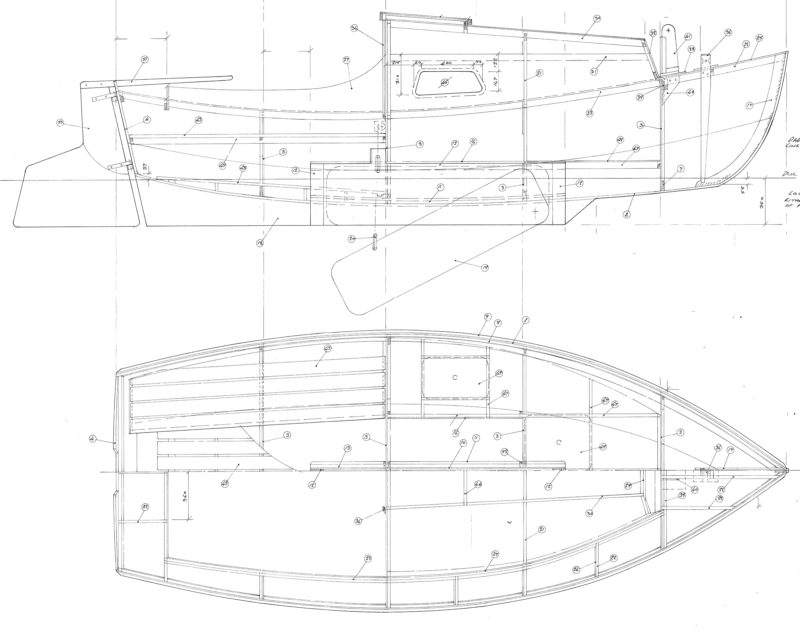
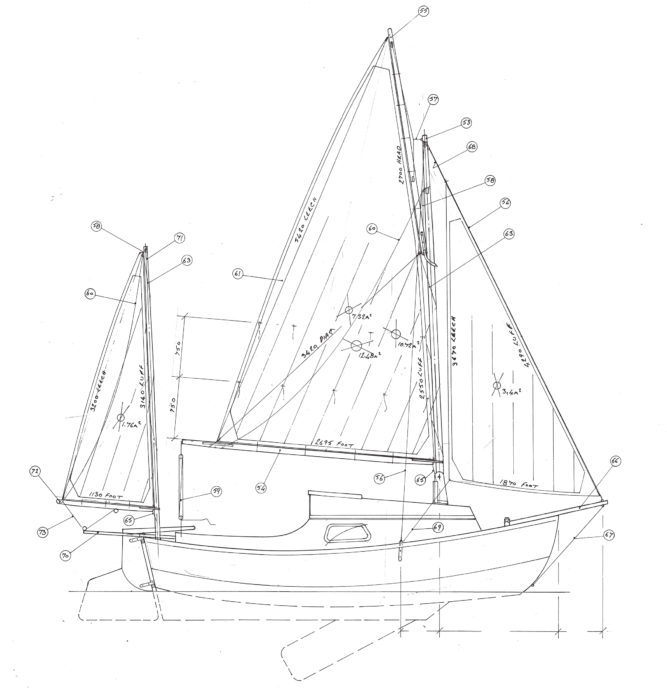
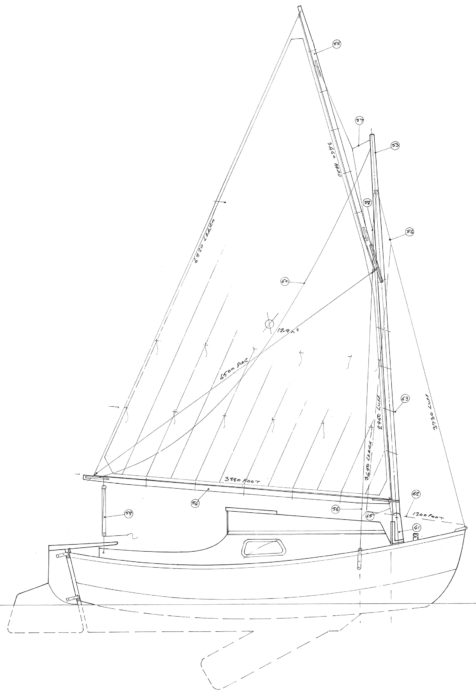
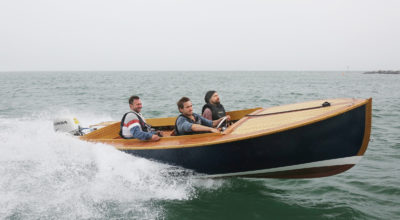
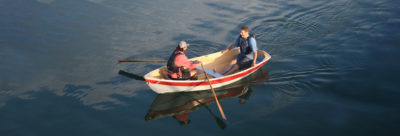

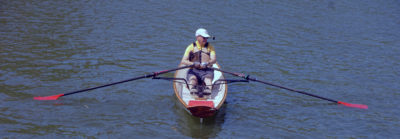

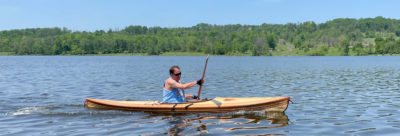


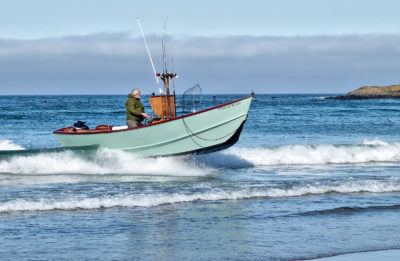
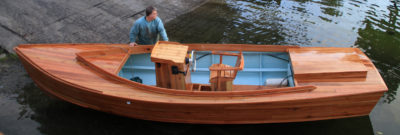
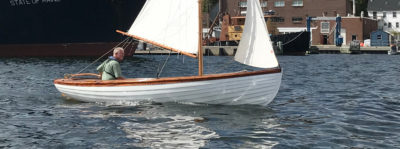
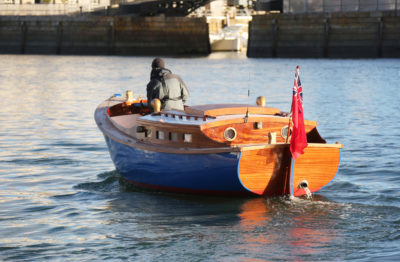

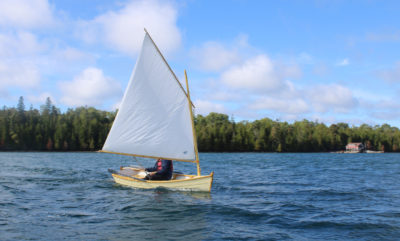
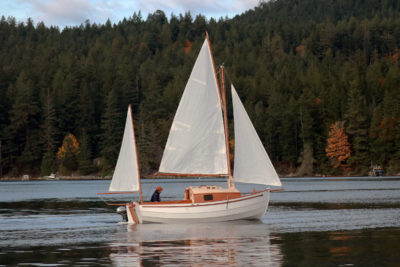
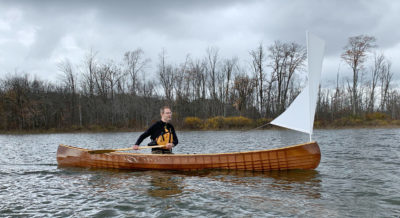
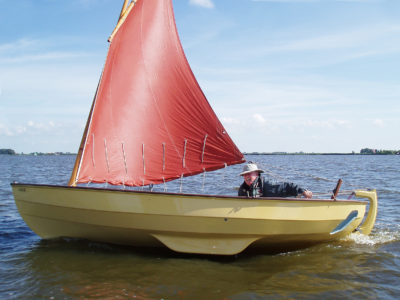
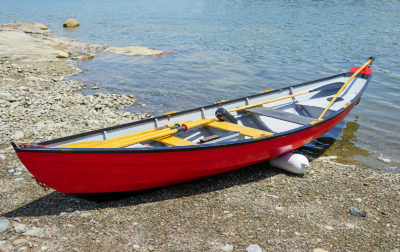
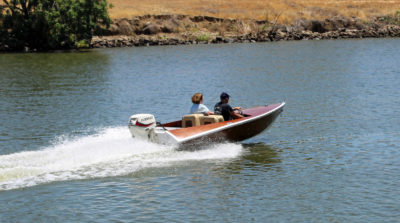
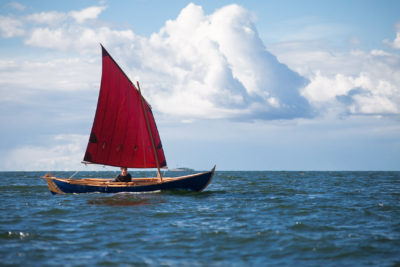
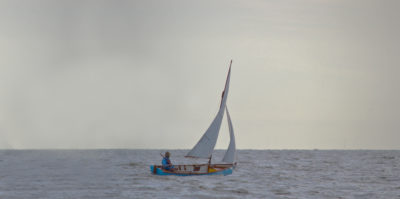
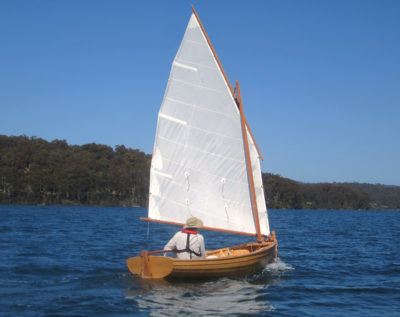
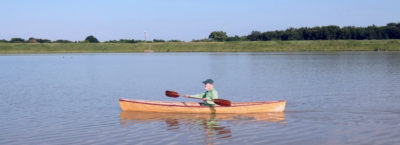
Wow! Amazing!
Do these plans include the modifications of the self draining foot wells and benches and storage space? Or are those changes a builder would have to figure out on their own?
Stacey, I modified the design according to a few of my own preferences. One was for a self-bailing cockpit floor and the other was for seats that would shed the rain water. These adaptations are well suited to our climate here on the west coast of Canada.
Hello Steve,
You have built a very charming pocket cruiser. You obviously have some accomplished woodworking skills. Are the protruding frames above the deck and the strong bulwark attached to them a modification to original design plans? A lovely and practical feature. How is the deck sealed around frames to ensure waterproofing? Is there room for a portable loo and small galley flat in the cabin? Any frustrating weather helm issues with the yawl rig?
Lawrence
Thanks, Lawrence. Yes, I did extend the frames to allow for the small bulwarks. I used epoxy putty to fill any voids then covered the deck with a 6-oz glass cloth set in epoxy. I have not had any issues with leaks as of yet.
I suppose you could fit a small portable loo if designed in during construction; same for the galley. I might suggest a galley that could be set up when needed and stowed especially at night when you need the space for the berth.
I don’t recall any issues with weather helm as of yet, and am more than happy to have the option of dousing the main altogether should the conditions require it.
I watched your video of your Black Swan project and of your Ptarmigan 17 build. I am certain Paul Fisher must be very pleased and honoured by your handiwork. Congratulations!
Lawrence
Do you suppose the cat rig could be replaced by a junk rig fairly easily, with the sacrifice of a through-cabin mast?